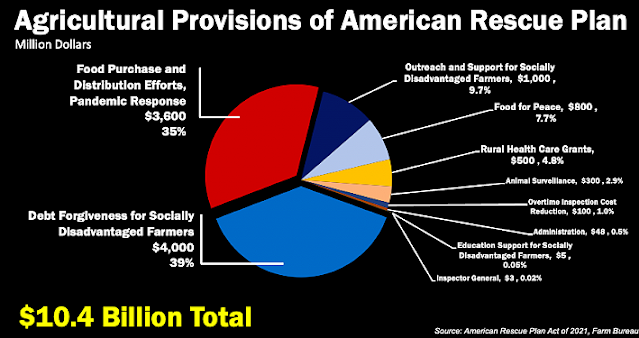 |
| American Farm Bureau Federation chart |
We covered what was in the House version of the bill, but here's what's new in the amended Senate version:
- The $15-per-hour minimum wage hike was scrapped. after the Senate parliamentarian ruled that it couldn't be included in a bill passed by reconciliation.
- A new provision would provide $1.5 billion over two years to counties with large swaths of federal public land not subject to property taxes. The funding would be distributed based on the county's economic needs.
- Expanded federal unemployment benefits would be extended through Sept. 6, but at the current rate of $300 a week, not $400, as in the House version. The first $10,200 of benefits would be tax-free for households earning under $150,000 a year.
- Eligibility requirements were tightened for the $1,400 stimulus checks.
- Struggling rural health-care providers who have not yet received their share of pandemic relief money would get $8.5 billion.
- 100% of health-care premiums under the COBRA law would be subsidized through September, to ensure that laid-off workers can keep their health insurance. The House version capped premium subsidies at 85% of the cost.
- The $350 billion in direct aid for state and local governments can only cover costs incurred by the end of 2024, and that money can't be used to offset tax cuts or create a pension fund.
- Restrictions on aid to governments were broadened to give them more flexibility to pay some workers more hazard pay.
- Small states must get at least as much direct aid as they got from the relief package passed in March 2020.
- States, territories and tribal governments will receive $10 billion under a new "critical infrastructure projects" program.
- Funding for the Economic Development Administration would rise to $750 million to help communities hurt by job and revenue losses related to the decline in tourism, travel and outdoor recreation.
- The Senate greenlit $510 million more than the House to fund the Federal Emergency Management Agency's program for homeless services programs and food banks.
- The extra FEMA funding would also provide one month's rent or mortgage payment to help prevent evictions, as well as one month's utility payments to prevent service cutoffs.
- Increased funding for the United States Digital Service would help meet high demand from agencies that need help providing services such as vaccine distribution, unemployment assistance and stimulus checks.
- Any student loan forgiveness law passed between Dec. 31, 2020 and Jan. 1, 2026 would be tax-free, ensuring that the forgiven debt could not be treated as taxable income.
No comments:
Post a Comment